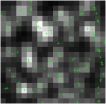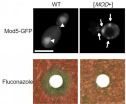(Press-News.org) Researchers from the Georgia Institute of Technology and University of California San Francisco have advanced scientists' ability to view a clear picture of a single cellular structure in motion. By identifying molecules using compressed sensing, this new method provides needed spatial resolution plus a faster temporal resolution than previously possible.
Despite many achievements in the field of super-resolution microscopy in the past few years with spatial resolution advances, live-cell imaging has remained a challenge because of the need for high temporal resolution.
Now, Lei Zhu, assistant professor in Georgia Tech's George W. Woodruff School of Mechanical Engineering, and Bo Huang, assistant professor in UCSF's Department of Pharmaceutical Chemistry and Department of Biochemistry and Biophysics, have developed an advanced approach using super-resolution microscopy to resolve cellular features an order of magnitude smaller than what could be seen before. This allows the researchers to tap previously inaccessible information and answer new biological questions.
The research was published April 22, 2012 in the journal Nature Methods. The research is funded by the National Institutes of Health, UCSF Program for Breakthrough Biomedical Research, Searle Scholarship and Packard Fellowship for Science and Engineering.
The previous technology using the single-molecule-switching approach for super-resolution microscopy depends on spreading single molecule images sparsely into many, often thousands of, camera frames. It is extremely limited in its temporal resolution and does not provide the ability to follow dynamic processes in live cells.
"We can now use our discovery using super-resolution microscopy with seconds or even sub-second temporal resolution for a large field of view to follow many more dynamic cellular processes," said Zhu. "Much of our knowledge of the life of a cell comes from our ability to see the small structures within it."
Huang noted, "One application, for example, is to investigate how mitochondria, the power house of the cell, interact with other organelles and the cytoskeleton to reshape the structure during the life cycle of the cell."
Currently, light microscopy, especially in the modern form of fluorescence microscopy, is still used frequently by many biologists. However, the authors say, conventional light microscopy has one major limitation: the inability to resolve two objects closer than half the wavelength of the light because of the phenomenon called diffraction. With diffraction, the images look blurry and overlapped no matter how high the magnification that is used.
"The diffraction limit has long been regarded as one of the fundamental constraints for light microscopy until the recent inventions of super-resolution fluorescence microscopy techniques," said Zhu. Super-resolution microscopy methods, such as stochastic optical reconstruction microscopy (STORM) or photoactivated localization microscopy (PALM), rely on the ability to record light emission from a single molecule in the sample.
Using probe molecules that can be switched between a visible and an invisible state, STORM/PALM determines the position of each molecule of interest. These positions ultimately define a structure.
The new finding is significant, said Zhu and Huang, because they have shown that the technology allows for following the dynamics of a microtubule cytoskeleton with a three-second time resolution, which would allow researchers to study the active transports of vesicles and other cargos inside the cell.
Using the same optical system and detector as in conventional light microscopy, super-resolution microscopy naturally requires longer acquisition time to obtain more spatial information, leading to a trade-off between its spatial and temporal resolution. In super-resolution microscopy methods based on STORM/PALM, each camera image samples a very sparse subset of probe molecules in the sample.
An alternative approach is to increase the density of activated fluorophores so that each camera frame samples more molecules. However, this high density of fluorescent spots causes them to overlap, invalidating the widely used single-molecule localization method.
The authors said that a number of methods have been reported recently that can efficiently retrieve single-molecule positions even when the single fluorophore signals overlap. These methods are based on fitting clusters of overlapped spots with a variable number of point-spread functions (PSFs) with either maximum likelihood estimation or Bayesian statistics. The Bayesian method has also been applied to the whole image set.
As a result of new research, Zhu and Huang present a new approach based on global optimization using compressed sensing, which does not involve estimating or assuming the number of molecules in the image. They show that compressed sensing can work with much higher molecule densities compared to other technologies and demonstrate live cell imaging of fluorescent protein-labeled microtubules with three-second temporal resolution.
The STORM experiment used by the authors, with immunostained microtubules in Drosophila melanogaster S2 cells, demonstrated that nearby microtubules can be resolved by compressed sensing using as few as 100 camera frames, whereas they were not discernible by the single-molecule fitting method. They have also performed live STORM on S2 cells stably expressing tubulin fused to mEos2.
At the commonly used camera frame rate of 56.4 Hertz, a super-resolution movie was constructed with a time resolution of three seconds (169 frames) and a Nyquist resolution of 60 nanometers, much faster than previously reported, said Zhu and Huang. These results have proven that compressed sensing can enable STORM to monitor live cellular processes with second-scale time resolution, or even sub-second-scale resolution if a faster camera can be used.
INFORMATION:
Compressed sensing allows super-resolution microscopy imaging of live cell structures
2012-04-24
ELSE PRESS RELEASES FROM THIS DATE:
Epoque Hotels Proudly Announces Hotel Navarra, Brugge as A New Member
2012-04-24
Hotel Navarra - Hospitality at its best!
Epoque Hotels is proud to welcome a new member to its boutique hotels collection, Hotel Navarra in Brugge. In one of the most unique and beautiful cities in Europe, this is an exciting moment for Epoque Hotels.
Hotel Navarra is listed as a historic monument from the 17th century, once standing as a mansion that even to this day has retained its original essence and charm. To make this feeling even more in the style of the Renaissance, the Hotel Navarra is located in the heart of Bruges - UNESCO World Heritage City �EUR" ...
UAE Exchange Wins Best Service Performance Outlet Award Under DSES
2012-04-24
'Service is our currency' asserts the tagline of UAE Exchange, the leading global remittance and foreign exchange brand. The brand has proved what it believes in, yet again, by winning the 'Best Service Performance Outlet Award' for 2011 under the Dubai Service Excellence Scheme (DSES), organised by Department of Economic Development and the Government of Dubai. H.H. Sheikh Maktoum Bin Mohammed Bin Rashid Al Maktoum, Deputy Ruler of Dubai, presented the award on 4th April, 2012 at Dubai World Trade Centre, Dubai.
"We are extremely happy with this achievement!" ...
New yeast prion helps cells survive
2012-04-24
One of the greatest mysterious in cellular biology has been given a new twist thanks to findings reported in Science. Researchers at the RIKEN Brain Science Institute show that prions, proteins that transmit heritable information without DNA or RNA, can contribute to drug resistance and cellular adaptation. Their discovery of a yeast prion with these properties demonstrates the active role of the prion conversion in cellular fitness adaptation, providing new insights into the potentially broader function of prions in living organisms.
Since their discovery in the 1960s, ...
Caribbean Hotel and Resort Investment Summit Selects Perspective Magazine As A Media Sponsor
2012-04-24
Perspective Magazine has joined a select group of industry leaders and businesses as a Sponsor for the Caribbean Hotel and Resort Investment Summit (CHRIS), scheduled for May 7-8, 2012 at the JW Marriott Marquis Miami in Miami, Florida.
"We are pleased to have Perspective Magazine sign on as a Media Sponsor of CHRIS," stated Jim Burba, president of BHN and the producer/host of CHRIS. "It is an exciting time to be hosting CHRIS as the Caribbean is evidencing growth after the recent more difficult years. There may be no better time to get down to business ...
New guidelines: Treatments can help prevent migraine
2012-04-24
NEW ORLEANS – Research shows that many treatments can help prevent migraine in certain people, yet few people with migraine who are candidates for these preventive treatments actually use them, according to new guidelines issued by the American Academy of Neurology. The guidelines, which were co-developed with the American Headache Society, will be announced at the American Academy of Neurology's 64th Annual Meeting in New Orleans and published in the April 24, 2012, print issue of Neurology®, the medical journal of the American Academy of Neurology.
"Studies show that ...
The effects of weak magnetic fields on cancer cells and other aspects of biology
2012-04-24
We are surrounded by a constantly changing magnetic field, be it the Earth's or those emanating from devices, such as cell phones. Carlos Martino, an assistant professor at the University of Nevada, Reno, is interested in understanding how these magnetic-field fluctuations change biochemical reactions inside us.
Martino explains that the subject is controversial. "Our research shows that exposure to different types of magnetic fields affect biological response," he says. "More importantly, the exposure levels are well below the standard levels" approved by the World ...
Seven Reasons Why Every Leader Needs to Understand Shame
2012-04-24
No one wants to talk about shame. Isn't shame something that addicts talk about? Or counselors? That's good for them but most of us deal with more functional people who don't have shame...right?
Brene Brown, research professor of shame and vulnerability at the University of Houston, disagrees. She says that shame is something everyone has. It's universal. And it has reached epidemic proportions. Brown is often tapped by Fortune 500 companies to enhance work performance and spur innovation.
Personally, I never set out to study shame. It wasn't on my radar. The ...
Researchers find potential link between drinking alcohol and breast cancer
2012-04-24
A research team this week will present findings that they say may finally explain the link between alcohol consumption and breast cancer.
"Cells have different mechanisms to remove toxic substances, such as ethanol, the chemical name for alcohol, that represent a potential risk to them," explains María de Lourdes Rodríguez-Fragoso, professor of pharmacology and toxicology at the Universidad Autonoma del Estado de Morelos in Mexico. "Unfortunately, sometimes these mechanisms produce other toxic substances, including some that are associated with the development of different ...
Link between common environmental contaminant and rapid breast cancer growth
2012-04-24
Studies by researchers at Dominican University of California show that breast cancer cells become increasingly aggressive the longer they are exposed to small concentrations of cadmium, a heavy metal commonly found in cosmetics, food, water and air particles.
The study by Maggie Louie, associate professor of biochemistry, shows exposure to cadmium for prolonged periods of time can cause the progression of breast cancer to become more aggressive. Her findings will be presented Monday, April 23, at the annual meeting of the American Society for Biochemistry and Molecular ...
Japanese researchers show that acupuncture can improve skeletal muscle atrophy
2012-04-24
A team of Japanese researchers will reveal study results Monday at the Experimental Biology 2012 meeting that show how acupuncture therapy mitigates skeletal muscle loss and holds promise for those seeking improved mobility through muscle rejuvenation.
"It is my hope that this study will demonstrate acupuncture's feasibility with regard to improving health among the elderly and medical patients. Our findings could identify acupuncture as the primary nonpharmacological treatment to prevent skeletal muscle atrophy in the future," says Akiko Onda, an acupuncturist and graduate ...

